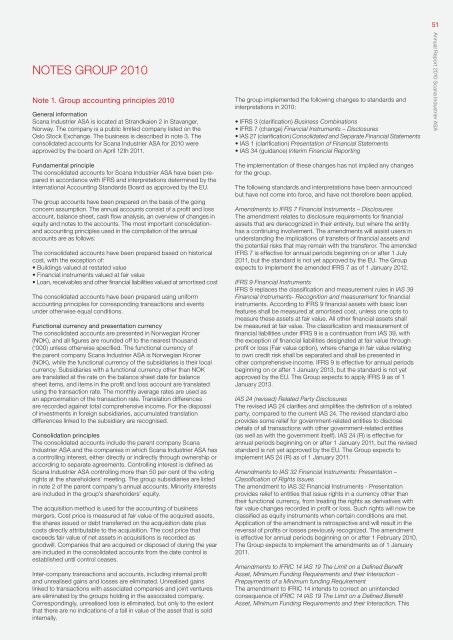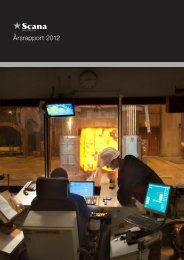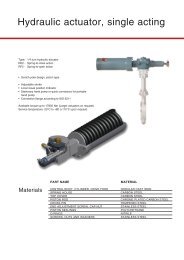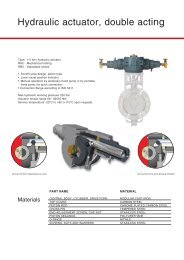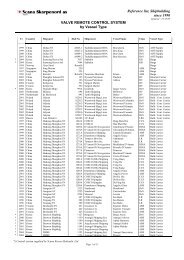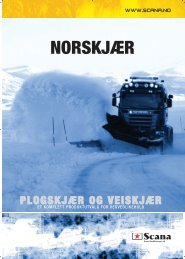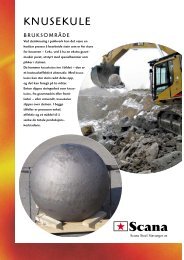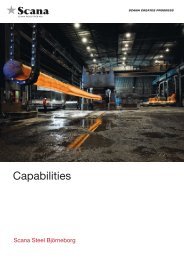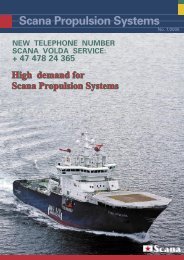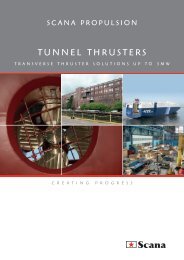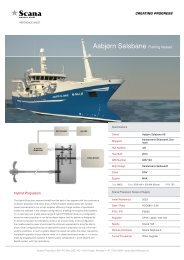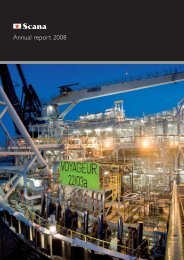Annual Report 2010 - Scana Industrier ASA
Annual Report 2010 - Scana Industrier ASA
Annual Report 2010 - Scana Industrier ASA
You also want an ePaper? Increase the reach of your titles
YUMPU automatically turns print PDFs into web optimized ePapers that Google loves.
51notes group <strong>2010</strong>Note 1. Group accounting principles <strong>2010</strong>General information<strong>Scana</strong> <strong>Industrier</strong> <strong>ASA</strong> is located at Strandkaien 2 in Stavanger,Norway. The company is a public limited company listed on theOslo Stock Exchange. The business is described in note 3. Theconsolidated accounts for <strong>Scana</strong> <strong>Industrier</strong> <strong>ASA</strong> for <strong>2010</strong> wereapproved by the board on April 12th 2011.The group implemented the following changes to standards andinterpretations in <strong>2010</strong>:• IFRS 3 (clarification) Business Combinations• IFRS 7 (change) Financial Instruments – Disclosures• IAS 27 (clarification) Consolidated and Separate Financial Statements• IAS 1 (clarification) Presentation of Financial Statements• IAS 34 (guidance) Interim Financial <strong>Report</strong>ing<strong>Annual</strong> <strong>Report</strong> <strong>2010</strong> <strong>Scana</strong> <strong>Industrier</strong> <strong>ASA</strong>Fundamental principleThe consolidated accounts for <strong>Scana</strong> <strong>Industrier</strong> <strong>ASA</strong> have been preparedin accordance with IFRS and interpretations determined by theInternational Accounting Standards Board as approved by the EU.The group accounts have been prepared on the basis of the goingconcern assumption. The annual accounts consist of a profit and lossaccount, balance sheet, cash flow analysis, an overview of changes inequity and notes to the accounts. The most important consolidationandaccounting prin ciples used in the compilation of the annualaccounts are as follows:The consolidated accounts have been prepared based on historicalcost, with the exception of:• Buildings valued at restated value• Financial instruments valued at fair value• Loan, receivables and other financial liabilities valued at amortised costThe consolidated accounts have been prepared using uniformaccounting principles for corresponding transactions and eventsunder otherwise equal conditions.Functional currency and presentation currencyThe consolidated accounts are presented in Norwegian Kroner(NOK), and all figures are rounded off to the nearest thousand(‘000) unless otherwise specified. The functional currency ofthe parent company <strong>Scana</strong> <strong>Industrier</strong> <strong>ASA</strong> is Norwegian Kroner(NOK), while the functional currency of the subsidiaries is their localcurrency. Subsidiaries with a functional currency other than NOKare translated at the rate on the balance sheet date for balancesheet items, and items in the profit and loss account are translatedusing the transaction rate. The monthly average rates are used asan approximation of the transaction rate. Translation differencesare recorded against total comprehensive income. For the disposalof investments in foreign subsidiaries, accumulated translationdifferences linked to the subsidiary are recognised.Consolidation principlesThe consolidated accounts include the parent company <strong>Scana</strong><strong>Industrier</strong> <strong>ASA</strong> and the companies in which <strong>Scana</strong> <strong>Industrier</strong> <strong>ASA</strong> hasa controlling interest, either directly or indirectly through ownership oraccording to separate agreements. Controlling interest is defined as<strong>Scana</strong> <strong>Industrier</strong> <strong>ASA</strong> controlling more than 50 per cent of the votingrights at the shareholders’ meeting. The group subsidiaries are listedin note 2 of the parent company’s annual accounts. Minority interestsare included in the group’s shareholders’ equity.The acquisition method is used for the accounting of businessmergers. Cost price is measured at fair value of the acquired assets,the shares issued or debt transferred on the acquisition date pluscosts directly attributable to the acquisition. The cost price thatexceeds fair value of net assets in acquisitions is recorded asgoodwill. Companies that are acquired or disposed of during the yearare included in the consolidated accounts from the date control isestablished until control ceases.Inter-company transactions and accounts, including internal profitand unrealised gains and losses are eliminated. Unrealised gainslinked to transactions with associated companies and joint venturesare eliminated by the groups holding in the associated company.Correspondingly, unrealised loss is eliminated, but only to the extentthat there are no indications of a fall in value of the asset that is soldinternally.The implementation of these changes has not implied any changesfor the group.The following standards and interpretations have been announcedbut have not come into force, and have not therefore been applied.Amendments to IFRS 7 Financial Instruments – DisclosuresThe amendment relates to disclosure requirements for financialassets that are derecognized in their entirety, but where the entityhas a continuing involvement. The amendments will assist users inunderstanding the implications of transfers of financial assets andthe potential risks that may remain with the transferor. The amendedIFRS 7 is effective for annual periods beginning on or after 1 July2011, but the standard is not yet approved by the EU. The Groupexpects to implement the amended IFRS 7 as of 1 January 2012.IFRS 9 Financial InstrumentsIFRS 9 replaces the classification and measurement rules in IAS 39Financial Instruments- Recognition and measurement for financialinstruments. According to IFRS 9 financial assets with basic loanfeatures shall be measured at amortised cost, unless one opts tomeasure these assets at fair value. All other financial assets shallbe measured at fair value. The classification and measurement offinancial liabilities under IFRS 9 is a continuation from IAS 39, withthe exception of financial liabilities designated at fair value throughprofit or loss (Fair value option), where change in fair value relatingto own credit risk shall be separated and shall be presented inother comprehensive income. IFRS 9 is effective for annual periodsbeginning on or after 1 January 2013, but the standard is not yetapproved by the EU. The Group expects to apply IFRS 9 as of 1January 2013.IAS 24 (revised) Related Party DisclosuresThe revised IAS 24 clarifies and simplifies the definition of a relatedparty, compared to the current IAS 24. The revised standard alsoprovides some relief for government-related entities to disclosedetails of all transactions with other government-related entities(as well as with the government itself). IAS 24 (R) is effective forannual periods beginning on or after 1 January 2011, but the revisedstandard is not yet approved by the EU. The Group expects toimplement IAS 24 (R) as of 1 January 2011.Amendments to IAS 32 Financial Instruments: Presentation –Classification of Rights IssuesThe amendment to IAS 32 Financial Instruments - Presentationprovides relief to entities that issue rights in a currency other thantheir functional currency, from treating the rights as derivatives withfair value changes recorded in profit or loss. Such rights will now beclassified as equity instruments when certain conditions are met.Application of the amendment is retrospective and will result in thereversal of profits or losses previously recognized. The amendmentis effective for annual periods beginning on or after 1 February <strong>2010</strong>.The Group expects to implement the amendments as of 1 January2011.Amendments to IFRIC 14 IAS 19 The Limit on a Defined BenefitAsset, Minimum Funding Requirements and their Interaction -Prepayments of a Minimum funding RequirementThe amendment to IFRIC 14 intends to correct an unintendedconsequence of IFRIC 14 IAS 19 The Limit on a Defined BenefitAsset, Minimum Funding Requirements and their Interaction. This


